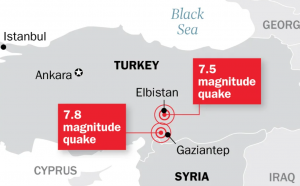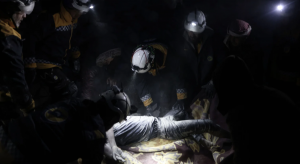 When a 7.8 magnitude earthquake struck southeastern Turkey and northwestern Syria early Monday morning local time, its tremor could be felt as far afield as Lebanon, Cyprus, Greece, Israel, and the Palestinian territories. A second quake, which recorded a magnitude of 7.5, struck just 9 hours later.
When a 7.8 magnitude earthquake struck southeastern Turkey and northwestern Syria early Monday morning local time, its tremor could be felt as far afield as Lebanon, Cyprus, Greece, Israel, and the Palestinian territories. A second quake, which recorded a magnitude of 7.5, struck just 9 hours later.
Both countries at the center are still reeling from the devastating aftermath, rescue workers on the ground tell TIME. So far, 11,200 people have been killed as a result of the quakes, and tens of thousands more have been injured. Thousands of buildings have also been reduced to rubble.
Though earthquakes are not uncommon in this part of the world, this week’s are believed to be the largest and deadliest to hit Turkey in decades. Here’s what we know so far.
When and where did the earthquakes in Turkey occur?
The initial earthquake struck the southern Turkish city of Gaziantep, roughly 150 miles away from the Turkey-Syria border, at 4:17 a.m. local time at a depth of about 11 miles, according to the U.S. Geological Survey. The second earthquake, the epicenter of which was roughly 80 miles north of Gaziantep in Turkey’s Kahramanmaras province, struck at 1:24 p.m. local time and was six miles deep, according to USGS.
More than 300 aftershocks rumbled after the initial quakes, according to Turkey’s Vice President Fuat Oktay.
How big is a 7.8 quake on the local magnitude scale?
While an earthquake magnitude of 2.5 or less can pass by undetected, earthquakes with a magnitude of 7.0 or higher are classified as a “major earthquake,” which can cause serious damage. A magnitude 8.0 or higher, considered “a great earthquake,” is capable of destroying entire communities.
While the magnitude of an earthquake denotes its size and strength, the potential damage caused by a quake is also determined by its depth (the shallower the quake, the more damaging) and its proximity to population centers.
In a tweet, U.S. Geological Survey seismologist Susan Hough likened the size of the initial earthquake in Turkey to San Francisco’s Great Earthquake of 1906, which left more than 3,000 dead and much of the city in ruin.
Are Turkey and Syria prone to earthquakes?
Earthquakes are not uncommon in Turkey. Most of the country is situated on the Anatolian Plate, which borders two major fault lines: the North Anatolian fault, which stretches across the country from west to east, and the East Anatolian fault, which is in eastern Turkey. The former has been the site of several disastrous earthquakes, according to the Geological Society of London, including the 1939 earthquake in northeastern Turkey that resulted in the deaths of 30,000 people.
Monday’s initial 7.8 magnitude earthquake is believed to have occurred on either the East Anatolian fault zone or the Dead Sea transform fault zone, according to USGS.
What is the scale of the damage?
The death toll has been staggering and surpassed 11,200 people as of Wednesday—a figure that is almost certain to continue to rise amid search and rescue efforts. More than 8,750 deaths have been reported in Turkey and 2,470 in Syria. The World Health Organization has warned that the combined count could reach 20,000, and that 23 million people could be affected by the disaster.
More than 44,000 people have also been reported injured so far, according to data from Turkey’s government, Syrian state media, and the humanitarian organization White Helmets.
Ismail Al Abdullah, a White Helmets volunteer contributing to rescue efforts near the Syrian-Turkish border, tells TIME that the aftermath of the earthquakes have been nothing short of “heartbreaking.” In the Syrian village of Sarmadā, where he is based, at least five buildings have collapsed, leaving many families trapped beneath the rubble.
“We tried our best to rescue them,” says Al Abdullah. “But we couldn’t. We couldn’t.”
As a veteran of the White Helmets, which was established as a volunteer corps of first responders during the Syrian Civil War, Al Abdullah isn’t new to search and rescue efforts. But even he admits that the scale of yesterday’s earthquakes pose an unprecedented challenge. “We’ve dealt with bombing, but this kind of natural disaster is bigger than us.”
While the full scale of the infrastructure damage is yet to be fully known, Orhan Tatar, general director of the country’s Disaster and Emergency Management Agency (AFAD), said Tuesday that it has received 11,342 reports of collapsed buildings—5,775 buildings have been confirmed.
Source: time









